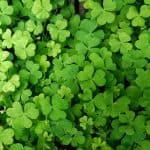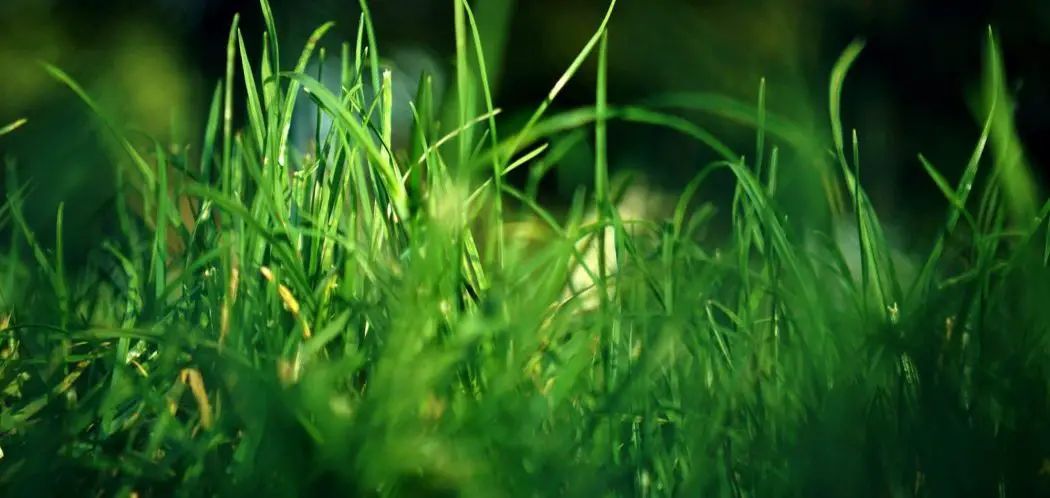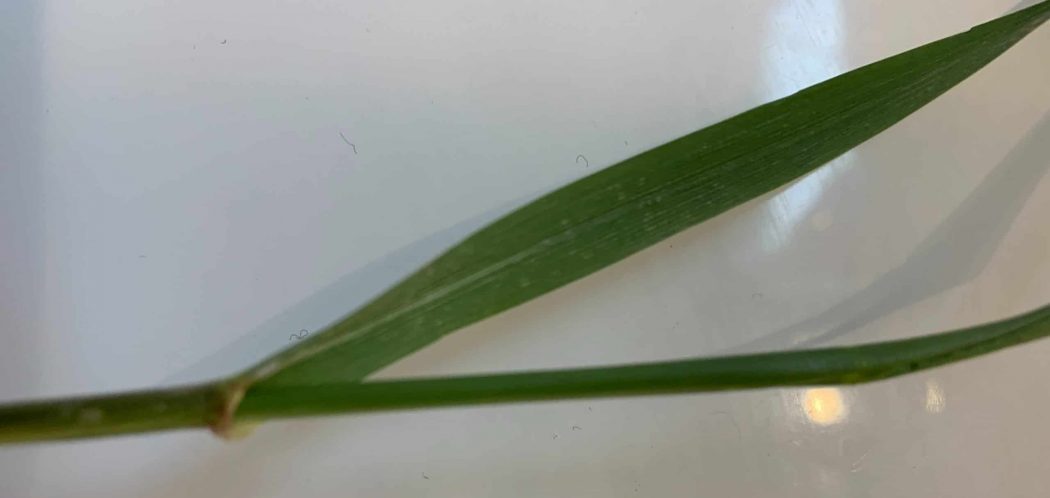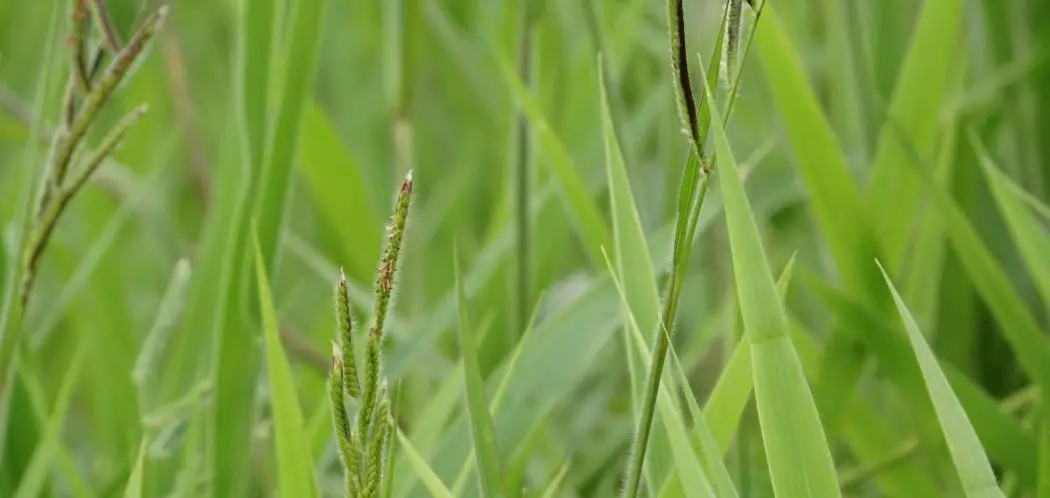Weeds will not only hurt the look of your lawn, they will also rob your turfgrass of sunlight, water and other nutrients.
Identifying weeds can be difficult since there are so many different types that might invade your lawn.
There are two types of weeds that you might see:
- Broadleaf weeds
- Grassy weeds
A broadleaf weed will have wide leaves and a different vein pattern to a grassy weed. Some of the broadleaf weeds have different colored flowers that you can use to help identify what you have.
In these two categories, you have:
- Annuals – These come up, seed and die all within one year
- Perennials – Come back year after year – A perennial nuisance!
The tricky thing with weed control is that some herbicides will work on some weeds, but not for others so it’s critical that you identify exactly what you have so that you can apply the right treatment.
In this article, we’ll include some specific recommendations on how to get rid of certain weeds, but in general the best way to keep weeds out of your lawn is to practice proper lawn maintenance. Any spots where the turf is thin are more susceptible to weed growth. A thick and healthy lawn will crowd out any opportunities for weeds to grow.
Proper lawn maintenance is the most effective part of weed prevention, therefore you need to make sure you are…
- Mowing to the correct height (not too short)
- Irrigating the lawn properly
- Minimizing thatch build up
- Alleviating soil compaction
- Fertilizing
- Reducing shade
Identifying Grassy Weeds
Annual Bluegrass
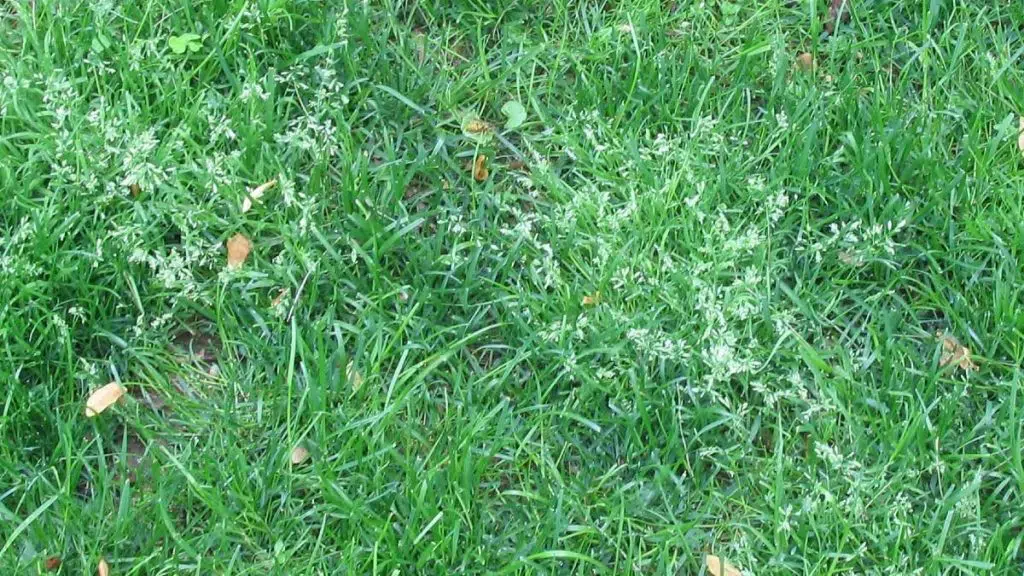
Poa Annua, also known as Annual Bluegrass can be a real problem in lawns. It’s a winter annual that starts growing in the fall. It grows throughout the winter and then dies once temperatures start to increase.
Poa annua will stand out from your existing turfgrass and it can really ruin the look of your lawn. You might be able to spot Poa Annua in your grass by looking for light green spots. Poa annua is usually always a lot lighter than your surrounding turfgrass, although when it dies in the spring, it can leave nasty brown patches. When you get closer you should be able to identify it by looking at the distinctive seed heads which stick outwards.
How to Control Annual Bluegrass
Controlling Poa annua is tricky because it produces lots of seeds in a single season.
The best control for annual bluegrass is going to be a pre-emergent herbicide. Putting a pre-emergent down early in the fall before soil temperatures go below 70 degrees will prevent the seeds from sprouting in the winter time.
You can use the exact same product to control Poa Annua that you would use to control crabgrass, only you need to put it down at a different time of the year.
Crabgrass
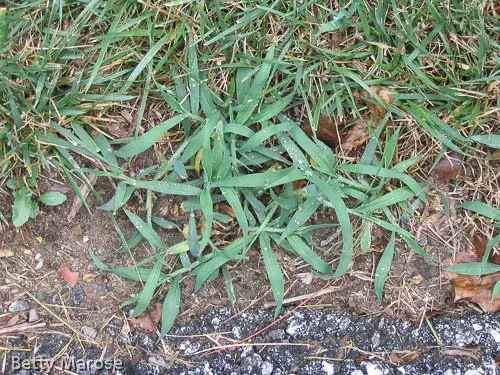
Crabgrass is an annual weed which you may see in the mid to late summer.
It certainly sticks out like a sore thumb! You’ll often see it in areas of your lawn that are either stressed out or thin.
It has a lime green color, thick blades and looks quite similar to dallisgrass and tall fescue.
It starts out very small and grows much larger if allowed to spread.
As the plant matures, you should see a fork-like seed head at the end of the plant.
You’ll frequently see crabgrass growing along the edges of your sidewalks where it has space to grow.
How to Control Crabgrass
There are probably lots of crabgrass seeds sitting in your soil at any point in time.
Crabgrass is an annual and so these seeds germinate once soil temperatures reach around 55F.
If you want to prevent these seeds from germinating, it’s best to put a pre-emergent down before then.
It can also be controlled with a post-emergent product. Typically, the active ingredient will be quinclorac.
If you don’t want to use a post-emergent herbicide product on your lawn, you could just wait until the first frost when crabgrass will start to die out.
Dallisgrass
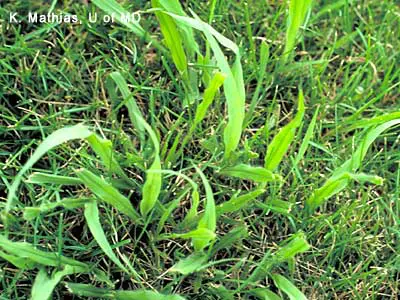
Dallisgrass is a bunch type grass that clumps together and it’s quite unsightly. It has broad blades that grow outwards. It often grows in a ring and you might see your turfgrass growing in the center where the dallisgrass strangles itself.
It looks quite similar to crabgrass although it has different seed heads. It’s out earlier in the season than crabgrass too!
How to Control Dallisgrass
Dallisgrass is arguably one of the worst weeds to have in your lawn. It has short rhizomes growing outwards making it hard to control.
Pre-emergents will not work since dallisgrass is a perennial.
Digging it up is going to be the best option.
You’re not going to be able to put down anything to kill dallisgrass that will not also kill your turfgrass.
Goosegrass

Goosegrass is a summer annual grassy weed that you’ll often see in areas of soil that have become hard, compacted or have poor drainage. For example, in areas where you have a lot of foot traffic or along sidewalks.
Goosegrass can be found in lawns all throughout the US. Whether you have a warm or cool season turfgrass, goosegrass can still grow.
You might be able to make out a wagon wheel shape where the dark green leaves grow out from the silver/gray base.
The seed head looks a bit like a zipper.
It’s often misidentified as dallisgrass or crabgrass.
Goosegrass germinates once soil temperatures warm to around 65F. It needs a good amount of sunlight and moisture to grow.
How to Control Goosegrass
To prevent goosegrass, you’ll want to use a pre-emergent application in the early springtime and then maybe another application later in the spring.
You’ll want to apply your pre-emergent before soil temperatures reach 60F in order to prevent the seeds from germinating.
You can also use post-emergent applications to kill it off too. Just be careful when using roundup since it will also kill your turfgrass.
Nimblewill

Nimblewill (Muhlenbergia schreberi) is a warm season, perennial, grassy weed.
It’s commonly mistaken for bermudagrass and creeping bentgrass.
It’s found all across North America. It favours a shaded, damp environment although it will spread into areas of sunlight also. I’ve found that it spreads very easily.
Nimbelwill spreads though your lawn by seeds and stolons.
It’s certainly more noticeable in cool season grass types. Especially when it goes dormant once temperatures start to drop in the fall. During this time, nimblewill has a light brown color leaving inconsistent patches on your lawn which is not a good look.
One of the best ways to identify nimblewill is to look at your lawn in the morning when dew is sitting on your grass. If nimblewill is present, you’ll notice distinct patches.
How to Control Nimblewill
The fact that nimblewill is a perennial and has a stolon system makes it difficult to control.
For most grass types, the best way to kill nimblewill is to use multiple applications of tenacity. This will kill the nimblewill but not your turfgrass.
Of course, roundup can also be used but this will kill your turfgrass too.
Digging up nimblewill patches may also be appropriate.
Quackgrass

Quackgrass is a really thick and tough cool season, perennial grassy weed that sticks out like a sore thumb in a lawn. It has a wide blade and unlike crabgrass, it has a long root system with rhizomes that go deep into the ground.
It can be a real pain to deal with and it keeps coming back year after year. It does well in areas where turfgrass may struggle.
It looks quite similar to other grass types although its often lighter in color.
This weed grows very quickly and so it’s likely going to be a lot taller than any surrounding turfgrass you have. It spreads by rhizomes, much like yellow nutsedge.
Quackgrass can also be identified from its auricles that grasp the stem.
How to Control Quackgrass
Hand pulling quackgrass isn’t easy because of its long root system.
Much like crabgrass, the best way to control quackgrass is to establish a thick and healthy lawn to crowd it out.
Quackgrass is a perennial so if you want to use a post emergent, you’re likely going to have to use roundup.
Yellow Nutsedge

Yellow nutsedge (Cyperus esculentus) is a weed that looks a lot like other turf types. It also goes by nutgrass and watergrass although it’s not actually a grass.
Yellow nutsedge is often confused with having slightly yellow turf from having micronutrient deficiencies in the grass but in reality, it’s an actual perennial weed coming up.
At a first look, yellow nutsedge does lot a lot like grass but if you look closely enough, you’ll see it has a triangular stem made of three leaves indicating that it is a sedge and not a grass. The leaves are quite waxy too.
Yellow nutsedge tends to grow really fast. It’s really invasive too!
It reproduces by nutlets.
How to Control Yellow Nutsedge
It tends to show up in the early spring or summer which is usually the best time to control it. It’s much harder to kill later in the year once it starts sending out rhizomes.
One option of removing yellow nutsedge is to hand pull it during the early growth stages and when the soil is moist. Once the weed gets more established, this is going to be much harder to do.
It’s very unlikely that you’re going to get rid of yellow nutsedge by a single application of any product.
To remove nutsedge chemically, you’ll want to use a selective herbicide product like sedgehammer or prosedge.
Identifying Broadleaf Weeds
American Burnweed

American burnweed (Erechtites hieraciifolius) is native to the US and Canada although it can be found all over the world growing in a wide variety of conditions.
It’s also known by several other names. Some of these are:
- Fireweed
- Butterweed
- Pilewort
American burnwweed is a summer annual and a member of the daisy Asteraceae family.
American burnweed grows tall (300cm) and it grows particularly fast.
It’s often called fireweed because it’s found in disturbed areas affected by fire.
It has upright flower heads and alternate spiral leaves that can vary quite a lot in size and shape.
Not many things eat American burnweed. It has a low wildlife value and it can be toxic to some animals.
How to Control American Burnweed
American burnweed has a shallow root system so hand pulling it is a sensible option.
Broad spectrum herbicides are the most effective way to control American burnweed.
Herbicides with a single active ingredient tend to be less successful.
Black Medic

Black medic (Medicago luplina) is an annual weed that goes by a few other names too. You might hear it referred to as:
- Yellow trefoil
- Black clover
- blackweed
Black medic is a member of the legume family. It looks very similar to white clover and oxalis.
Like clover, it also has three leaflets although it differs from clover in that it’s center leaf sits up on a petiole.
Another feature of black medic is a small yellow flower.
Black medic can be a summer or winter annual.
How to Control Black Medic
Since black medic thrives in compacted soil, a good way to prevent black medic is to aerate your lawn to aleviate soil compaction.
Non-selective broadleaf herbicides are typically effective to kill black medic. Appling treatments in the early growth stages will yield the best results.
Carpetweed
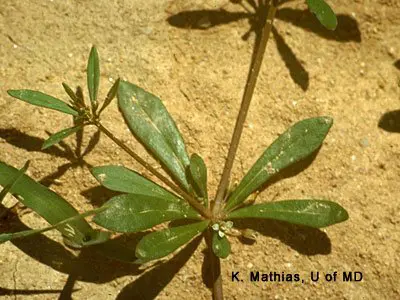
Carpetweed (Mollugo verticillate) is a small, summer annual weed often found in lawns across north America.
Carpetweed is also called Indian chickweed or the devils grip.
It has a light green color with egg shaped leaves that form in whorls. At each node, there are between 3 and 8 leaves.
It has branches that lie low to the ground forming a prostrate mat. The branches are so low that running over carpetweed with a mower has no effect.
Carpetweed can cover quite a large area when it’s allowed to spread. It spreads by seeds at a very rapid rate, especially on thin turf.
In the late summer, you might see small white flowers.
Although carpetweed thrives in soil holding a good amount of moisture, in can also grow in drier soils too.
How to Control Carpetweed
Since carpetweed does well on thinning turf, maintaining a thick and healthy lawn is your best defence.
Post emergent herbicides that are effective for carpetweed are best applied when the plant is growing.
I’d recommend using glyphosate or quinclorac.
Prostrate Spurge

Prostrate Spurge (Euphorbia humistrata) is an annual weed that’s common to find in lawns across North America. This weed spreads by seeds that sprout in the spring and summer when soil temperatures reach around 75F. Of course, soil temperatures will vary by location and the surface.
Prostrate spurge dies off in the fall.
It grows very low to the ground and is often found in cracks between sidewalks, brick walls or disturbed areas.
The leaves have a dark green color and are oval-shaped. You may also notice milk sap appearing upon breaking the stem. This sap can actually be toxic to animals if ingested.
How to Control Prostrate Spurge
There are essentially two ways to control prostrate spurge. Either by using a pre or post emergent.
The best way to control spurge is to prevent it from sprouting in the first place by using a pre-emergent product.
It’s good to keep track of your soil temperature and apply your pre-emergent before it reaches 75F.
The best post emergent to use on spurge on other weeds found in cracks is 41% glyphosate (aka roundup).
Canada Thistle
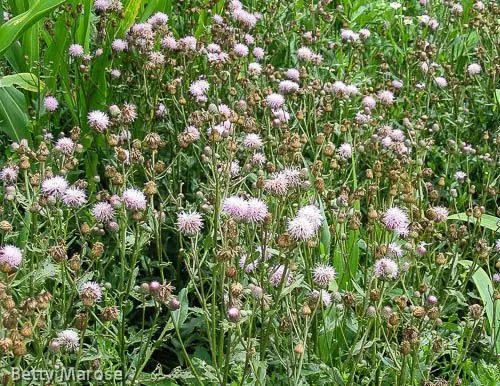
Canada thistle (Cirsium arvense) is a creeping perennial that has rhizomes. It’s common to find and it is quite invasive but it doesn’t do well in areas where there is a lot of competition. This is why you will often see it without anything around it.
It is colonial so it tends to spread in large patches.
Canada thistle tends to do better in wetter areas although it can tolerate some dry conditions too.
It’s important to make a distinction between Canada thistle and other bi-annual thistles because the management can vary quite a bit.
One way that Canada thistle can be identified is by its creeping perennial roots.
It also has an alternate leave pattern and these are very prickly. You’ll notice that there are no spines on the stems at all, and the spines all point out from the edges of the leaves only.
You won’t see any hairs on the upper side of the leaf although you might see some small hairs on the lower side once the plant matures.
In the summertime, you will be able to see its distinctive purple flowers that are very small. These do not have any prickly spines on them at all. Later on in the season, these produce small white fluffy seeds which can blow off and disperse.
How to Control Canada Thistle
The best control for Canada thistle is to provide it with competition.
The best time to apply a control method to Canada thistle is in the fall when the plant is at its weakest.
Clover
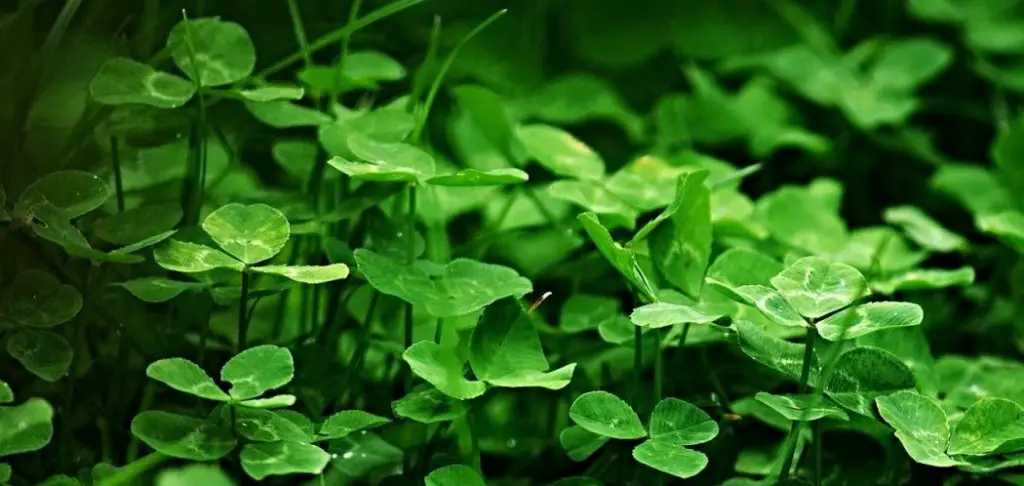
Clover is a very common weed to find all over the US. It’s a short-lived perennial and a member of the legume family. It’s fairly easy to identify clover by looking at its round leaflets.
Clovers lawns used to be very popular. It stays green all summer, requires very little maintenance and it can grow in less than ideal soil conditions although it doesn’t tolerate lots of foot traffic very well. You don’t have to worry about mowing either!
One of the main benefits is that clover fixes nitrogen in a lawn. It takes it from the air and allows it to be utilized by your grass. For this reason, some people actually throw down lawn clover seed on purpose.
You might see the surrounding grass and plants have a darker green colour where there is clover growing.
The two types most often used in lawns are:
- Micro clover
- White clover
How to Control Clover
The best way to prevent clover is to have a thick and healthy turf.
Once it is established, you can either pull it out or use a herbicide as a last resort.
Herbicides with the active ingredients Dicamba or Triclopyr will work best for clover.
Chickweed
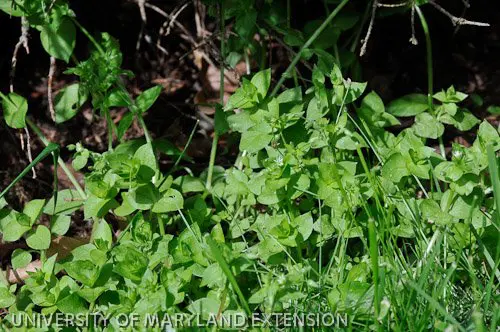
Common Chickweed (Stellaria media) is a herb native to Europe, but it’s a very common weed to see in lawns across north America during winter. It’s a winter annual that germinates when the conditions are wet and cool.
Chickweed is a herb that has a light green color. It grows low to the ground, almost never above a couple of inches.
It has spade-shaped opposite leaves and an elastic core. If you look closely, you should see a single line of hairs on the stem.
This plant can produce hundreds of seeds that can lay dormant for many years.
Chickweed flowers usually bloom in spring although you may see them year-round if the conditions are right.
How to Control Chickweed
Make sure your mowing height isn’t too low and ensure a proper irrigation programme to avoid excess moisture.
The best way to prevent chickweed is to use a pre-emergent in the fall.
Common chickweed has shallow roots. You can take advantage of this by pulling as much of it out as you can.
Chickweed is going to go away when it gets warm, but if you want to use chemical treatment when its established, you’ll need to use a non-selective broadleaf herbicide.
Henbit

You might see new henbit plants pop up early in the season. It’s a winter annual that sprouts in the winter and then blooms early in the spring. Of course, this is going to depend on how quickly things warm up.
It has flowers that are really high in nectar and pollen.
Henbit is in the mint family. You can usually tell a plant is in the mint family by looking for square stems.
Henbit is edible, that being said don’t go out and munch on it in the wild. Often times, herbicides are put down so you’ll want to be careful.
How to Control Henbit
Henbit often takes advantages of areas that have thin turf which may be because there is either too much shade or moisture so you’ll want to address these if possible.
The best way to prevent henbit is to use a pre-emergent herbicide. Isoxaben is generally used to prevent broadleaf weeds like henbit.
Once henbit is already established, using a 3-way herbicide – a post emergent herbicide will work best on henbit in the fall. You can then repeat applications in the spring when your turfgrass is growing strong.
Common Lespedeza
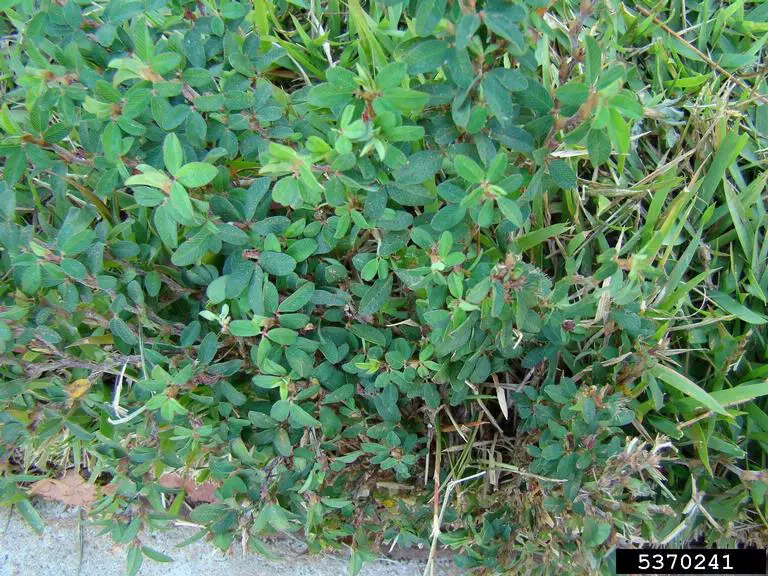
Lespedeza or Japanese clover is a summer annual weed that tends to be successful in centipede grass.
It has small groups of three dark green leaves with small edges.
There are small hairs on the stem and it’s sometimes you might see it produce a pink flower.
It can often get confused with clover or spurge.
Lespedeza is more successful in thin turf and in areas where the soil is compacted.
How to Control Common Lespedeza
Since lespedeza favours thin turf and grows low to the ground, having a lush thick lawn is the best way to prevent the weed from establishing itself. Having a proper mower height is one of the best things you can do.
It also favours compacted soil, so aerating can also help to keep it out your yard.
If you’re going to use a chemical treatment, look for a selective broadleaf product that contains active ingredients like 2, 4-D or dicamba.
Yellow Wood Sorrel

Yellow wood sorrel (common yellow oxalis) is a cool season perennial and it’s a part of the Oxalidaceae family. It looks a lot like clover/black medic and it’s fairly easy to recognize.
The leaf has a very light shade of green, it’s got trifoliates with heart shaped leaves that have a sour taste and sometimes get added to salads.
You might see a distinctive five-petal yellow flower that forms in the summer.
It’s low spreading and it tends to grow very quickly through seeds, rhizomes and stolons, especially when the soil is open.
The plant grows fastest in the spring and in the fall but it will be present all year round.
I usually see yellow wood sorrel growing best early in the spring. It does well when the soil is fertile although it can grow in a variety of conditions.
How to Control Yellow Wood Sorrel
Yellow wood sorrel is very hard to control. The waxy cuticle slows down water-based herbicides.
Hand pulling oxalis is a viable option. Doing this when the soil is moist allows for the rhizomes to be removed more easily.
For chemical control, non-selective containing glyphosate will be an effective spot treatment for yellow wood sorrel.
Creeping Charlie

Creeping Charlie (Glechoma hederacea aka ground ivy) is a perennial that grows mostly during the fall.
Creeping Charlie is actually part of the mint family. It has square stems and opposed, kidney shaped leaves that are green and have tiny hairs.
This weed tends to thrive in shaded areas but it will grow in sunlight also.
You might be able to notice its aroma if you mow over it.
It has quite an aggressive growth habit. It has rhizomes so it can invasively move through your lawn if you don’t get it under control quickly.
It’s often misidentified as common mallow or purple deadnettle.
How to Control Creeping Charlie
Hand pulling creeping Charlie maybe a short-term solution, but its extensive root system makes it challenging to fully eradicate.
The best way to prevent creeping Charlie is adjust your cultural practice to improve the quality of your turf.
Creeping Charlie is pretty tough. While it is a broadleaf weed, not all broadleaf weed herbicides are going to be an effective control method.
Dicamba herbicides are going to be the most effective on creeping Charlie. You could also use borax but this will kill other plants too.
Treatment is best done during the fall.
Wild Onion and Wild Garlic
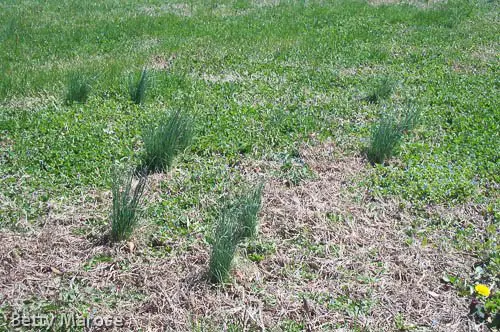
As soon as the weather starts to get cool in the fall, it’s very common for wild onion (Allium canadense) and wild garlic (Allium vineale) to start popping up everywhere.
These two cool-season, perennial weeds are usually grouped together. They are both members of the onion family and they do look similar to one another, and very much like grass with a slight u curve. You will notice a distinctive odor if you run over these with a mower or pull them out.
In order to tell the difference between wild onion and wild garlic, you’re likely going to have to break off the leaf. The leaf on wild garlic is hollow while the leaf on wild onion is solid.
How to Control Wild Onion and Wild Garlic
Pulling them is one option but the bulbs will remain in the soil if you’re not careful. To prevent these weeds from coming up again, it’s a good idea to dig them out with a shovel.
A lot of 3-way broadleaf herbicide products claim to control these two weeds, but I’ve found they don’t totally eradicate it from coming back the following year.
Spot spraying with Imazaquin is probably your best option.
Wild Violet

Wild violet (Viola papilionacea) is a stubborn perennial weed that grows low to the ground. It spreads by rhizomes and seeds.
Its more common to find wild violets in the US and in Canada than in Europe.
Wild violets have glossy heart shaped leaves. The leaves are very slippery so your normal 3-way herbicide will have a lot of difficulty in controlling wild violet. It has distinct purple-blue flowers that die off during warmer the temperatures in summer.
Wild violet grows very quickly. It has strong growth. Although this weed can grow in the sun, you’re much more likely to find it growing in shaded areas.
Wild violet has some medicinal properties and flowers are sometimes put in salads.
How to Control Wild Violet
Hand pulling wild violets is a viable option. This is more easily done when the soil is moist.
Carfentrazone, sulfentrazone, triclopyr, clopyralid are all labelled for wild violet.
Herbicides for wild violet are best used in the fall. I’d definitely recommend using a surfactant with any application.
Here are some of my favorite lawn care products
Thanks a lot for making it to the end of this post! I hope you found it useful. Here are some lawn care products that I use and that I think you’ll also find helpful. These are affiliate links, so if you do decide to use any of them, I’ll earn a commission.
In all honesty, these are some of the basic products that I use and recommend to everyone.
Broadcast Spreader
This Scotts Elite dual rotary spreader is not a professional grade model but it’s excellent for homeowners.
I really like the edge guard on it. It’s really easy to switch on and off so it’s great for going around my driveway and flower beds.
If you’re not looking to spend hundreds of dollars, I’d definitely recommend this model. It spreads out a wide path and is great quality for the cost.
Backpack Sprayer
This 4-Gallon sprayer is my absolute favorite. It sprays for a really long time. I’ve had this sprayer for quite a while and I’ve never had the battery run out.
The adjustable pressure switch is a really import feature to me.
You can order a lot of accessories for this model but I’ve never really found much of a need for it.
Head Aerator
Hand aerators are great for small spots if you’ve got construction debris or a spot that constantly dries out.
You can also fill these holes with organic matter that will hold a bit more moisture.
This one by Yard Butler is an absolute bargain. It pulls nice long cores. I also use it for taking soil samples around the yard!


